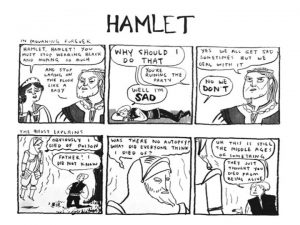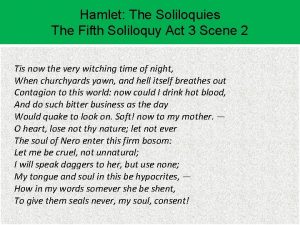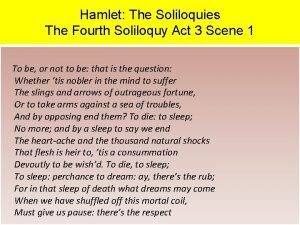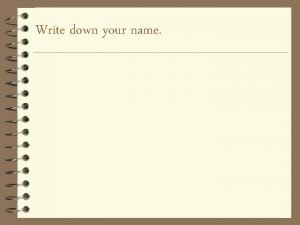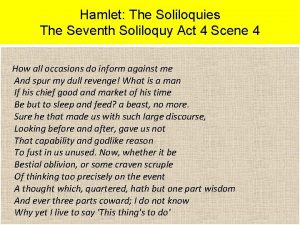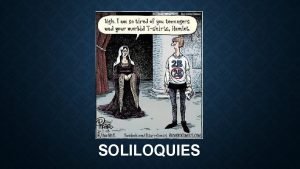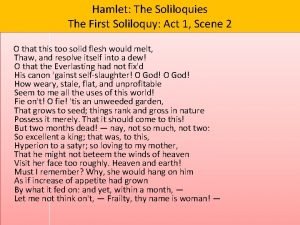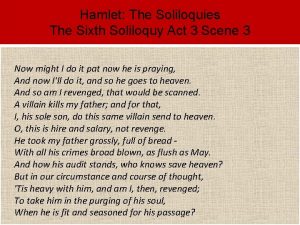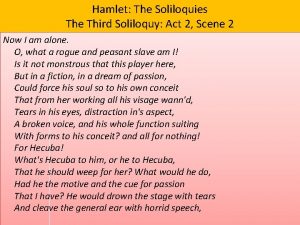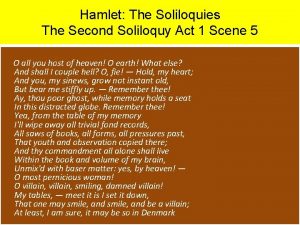Hamlets soliloquies Hamlet is famous for its soliloquies












- Slides: 12


Hamlet’s soliloquies • ‘Hamlet’ is famous for its soliloquies. Hamlet himself has 7, Claudius has 1. • A soliloquy is important as it means that the audience can gain a direct insight into the character’s thoughts, rather than that which they are presenting to other characters (think about that in relation to appearances vs reality). • One of Hamlet’s important characteristics is his propensity to overthink, therefore an insight into his thought process is important.

Soliloquy 1 Act I, Scene 2

O, that this too solid flesh would melt Thaw and resolve itself into a dew! Or that the Everlasting had not fix’d His canon ‘gainst self-slaughter! O God! How weary, stale, flat and unprofitable,

Seem to me all the uses of this world! Fie on’t! ah fie! ’tis an unweeded garden, That grows to seed; things rank and gross in nature Possess it merely. That it should come to this! But two months dead: nay, not so much, not two:

So excellent a king; that was, to this, Hyperion to a satyr; so loving to my mother That he might not beteem the winds of heaven Visit her face too roughly. Heaven and earth! Must I remember? why, she would hang on him,

As if increase of appetite had grown By what it fed on: and yet, within a month– Let me not think on’t–Frailty, thy name is woman!– A little month, or ere those shoes were old With which she follow’d my poor father’s body,

Like Niobe, all tears: –why she, even she– O, God! a beast, that wants discourse of reason, Would have mourn’d longer–married with my uncle, My father’s brother, but no more like my father Than I to Hercules: within a month:

Ere yet the salt of most unrighteous tears Had left the flushing in her galled eyes, She married. O, most wicked speed, to post With such dexterity to incestuous sheets! It is not nor it cannot come to good: But break, my heart; for I must hold my tongue.

Key points to discuss from Act I • (I. 1) – role of first scene in creating atmosphere of suspicion. Suggestion of all not being well in Denmark as a whole. • (I. 2) – Meeting the main characters – Hamlet, Gertrude, Claudius keen to smooth over death of King Hamlet, make amends with his son. Gertrude also seems keen that Hamlet should come round to the idea of new family roles. Hamlet still grieving fairly intensely over his father’s death. First soliloquy.

Key points to discuss from Act I • (I. 3) Meet Ophelia, Laertes. Double standards between the two. Polonius and Laertes’ treatment of Ophelia. Good point to consider how women’s roles are set up in the play. • (I. 4/5) Hamlet meets ghost. He is overwhelmed, but still has enough reason that he does not trust it outright. He promises to do what it asks. Change in character – however briefly – he is now more determined and asserts his resolve at the end of the act.

Act I – Ext. • How is an atmosphere of suspicion created in Act I Scene 1?
 All hamlet soliloquies
All hamlet soliloquies Hamlet's 5th soliloquy analysis
Hamlet's 5th soliloquy analysis Hamlet act 3 scene 1 soliloquy analysis
Hamlet act 3 scene 1 soliloquy analysis Hamlet soliloquys
Hamlet soliloquys Front doors tower hamlets
Front doors tower hamlets What is foil in literature
What is foil in literature Tower hamlets ethnicity
Tower hamlets ethnicity What claim does girard develop in this essay?
What claim does girard develop in this essay? Write the name of your mother
Write the name of your mother Hamlet character analysis
Hamlet character analysis Reset tower hamlets
Reset tower hamlets Hamlet's 7th soliloquy analysis
Hamlet's 7th soliloquy analysis Soliloquy definition
Soliloquy definition
